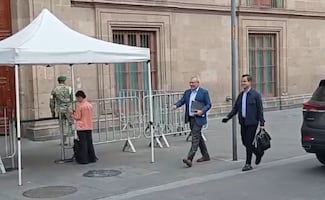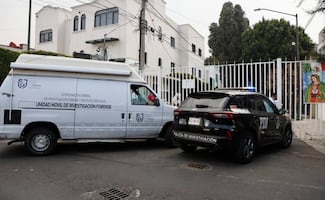Más Información

Senador del PT propone crear televisión, radio y periódico de la 4T; debemos hacer frente a medios de derecha, dice

César Duarte comparece ante jueza en penal del Altiplano; buscan vincularlo por presunto lavado de dinero

¿Qué es el Tratado de Aguas de 1944 entre México y EU por el que Trump amaga con imponer aranceles?; te explicamos

Gobernador de Michoacán se reúne con Sheinbaum en Palacio Nacional; acude también gabinete de Seguridad

Posponen en el Senado discusión y votación de reforma para crear la figura de “jueces sin rostro”; se discutirá en febrero

VIDEO Hallan a pareja sin vida en colonia Lindavista; una de las víctimas era abogado que litigó temas de despojos en Ecatepec
By the late 1960s , plastic bags started being used in the world as a revolutionary promise to carry goods. In a picture of the Ralphs shopping mall, a U.S. supermarket chain founded in the 20th century, there is a printed plastic bag of those years that promotes the advantages of their use. The promises are real: more resistant than paper bags, easy to carry, and water - repellent .
Finally, the motto shined: “The bag of the future is here, just for you.” The issue is that the future reached us and showed a humanity that abused the advantages of the volatile and apparently fragile plastic bag , up to the point of filling with it the most isolated places in the world, such as the ice caps and the highest peaks .
Did you know
?
Plastic bags began to accompany humans everywhere and even preceded our steps. They are in places that are difficult to reach for humans, like 10,000 meters deep in the darkest depths of the oceans where this material is accumulated as a metaphor of our excesses portrayed in real figures: It is calculated that there are 10,000 tonnes of this kind of plastic bags every year in the sea, and it has been registered that over 250 species have ingested these materials.
According to the text “From birth to ban: A history of the plastic shopping bag,” published by the UN’s Environmental Program , polyethylene, the plastic most commonly used for these means, was created by accident in a chemical factory in Northwich, England. The material was first secretly used by the British military during World War II until the design of the plastic shopping bag we know nowadays was patented by the Swedish company Celloplast and designed by engineer Sten Gustav Thulin . Since its creation, it quickly began to replace paper and fabric bags all over the world that are now claiming the crown.

The dangers
The first country that noticed the use of plastic shopping bags was not harmless was Bangladesh . 18 years ago, this Asian country discovered that plastic bags had an important role in the obstruction of sewage systems during floods . Currently, the problem areas unleashed by their impact are an international concern . China is the biggest generator of this kind of product; the Asian country will forbid plastic bags in its main cities by the end of 2020 and in the rest of the cities and towns for 2022 .
Have you heard
?
In the American continent, Chile became the first country to follow the measure over a year ago. Finally, in Mexico City, the Solid Wastes Law forbade the distribution, commercialization, and supply of single-use plastic bags to consumers except for its use to deliver products that must be packed due to hygiene. Nevertheless, there are still many issues to solve because it does not suffice with the satanization of plastic , which is actually a revolutionary material for the fabrication of multiple products that ease our lives in different ways. The problem, as is with everything related to the environment, has to do with the abuse and the culture of discarding things as a new lifestyle.

Ornella Garelli
, campaigner of Greenpeace Mexico’s “Oceans without Plastics” points out that the stance of environmental associations like the one she represents is the reuse in its widest sense. “When the measure started, some supermarkets in order to “support” it, gave away [fabric] bags but the idea is not to purchase new products but to use the ones we already have.”
The environmentalist stresses the relevance of reusing objects to transports things, like bags made from any resistant material, such as backpacks, nets, baskets, fabric, etc. “This is a true way of reducing environmental impact for we’re giving a new life to something that’s already at home. The problem is that we accept more bags or buy prettier ones, the impact will remain there but in a different way.”
Did you know that
?
In some stores of high commercial relevance in Mexico, like Sanborns, they substituted plastic bags for paper bags ; however, Garelli considers that this kind of actions is a false solution for it moves the problem of plastic pollution to the deforestation of forests, in addition of paper production also generating pollution for fossil fuels , water use, and emissions to the atmosphere , which contributes to global warming .
A world with less plastic
Bags: paper, fabric, organic fibers, or bio-plastic?
After the restriction for the supply of plastic bags in Mexico City, which are the most ecologic alternatives currently and will the future bring?
In the case of organic fibers bags , the stance is similar. It is not about how long it takes to degrade. Garelli says that there should be an analysis of the material in particular to know its impact and how the increase of its production would affect. “It cannot be said that all bags or baskets made from this kind of material do not cause problems because there are some that cause environmental pressure when they are made by using most lands for the production of a plant that can even put in danger the habitat of local species. The challenge is not to return to the idea of producing , consuming , and discarding . But to reuse up to the limits of imagination.”
Are
?
When the future reaches us
“These measures are important because they create more awareness in the population and although at first, it might seem that people cannot change, as happened, for instance, with the prohibition of smoking in closed spaces, this does help to create awareness of us having to become more responsible consumers with the planet.” Garelli says that this is a first step to open the door to bigger advances for these local efforts are also breeding in other 25 states in Mexico that are already creating laws in the matter and that seek to open new ways for a federal law.
Meanwhile, in laboratories in Mexico and the world, scientists are also experimenting to offer new alternatives to plastic. In the Biotechnology Institute of the National Autonomous University of Mexico , researchers are working with a bacteria called Azotobacter Vinelandii, which is present in dry leaves. After a fermentation process, it can produce a material similar to plastic that disintegrates in less time without polluting.
The precursors of bioplastics can be produced in big volumes using agribusiness waste, mainly from cellulose and hemicellulose. The sugar obtained from such wastes is used to obtain organic acids that are precursors of biopolymers .
Did you know microplastics pollution has reached the Arctic?
Precisely in the Chemistry Faculty of Autonomous University of Querétaro (UAQ) , they have designed a biopolymer based on subproducts of agribusiness such as corn cob and with which they could create bags similar to plastic that could even be eaten. On the other hand, researchers from the University of the Atemajac Valley in Jalisco are experimenting with a bioplastic that takes advantage of the properties of the Opuntia megacantha nopal, a species not eaten by humans, so it would not affect the food supply.
On a global scale, it is calculated that the production of bioplastic will represent 2.44 million tonnes by 2022 . Although the polluting impact of these products is less, the idea of reusing has become a priority not only for bags but as a consumption strategy in general in a time when waste seems to literally surpass us.
mp
Noticias según tus intereses
[Publicidad]
[Publicidad]








